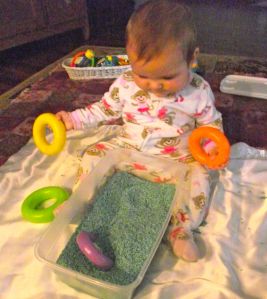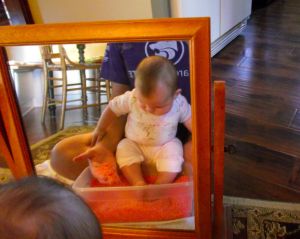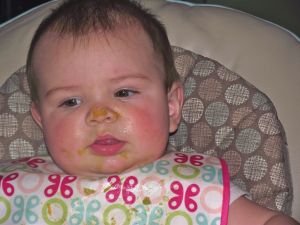I post a lot of pictures to my Facebook page of Stella engaging in sensory play. I try to offer some form of sensory play every day (it doesn’t always happen though) and I enjoy sharing what we do to give other parents ideas. In almost every picture’s comment section, you’ll find someone asking a variation of, “Doesn’t she put that in her mouth?” or “How do you keep her from eating that?” It’s a common question and a valid concern, so I decided to go ahead and blog about it.
To answer the question, yes, Stella puts things in her mouth. In fact, she puts almost anything into her mouth that she can get her little hands on! Mouthing is a typical (and good!) baby behavior because it is one of the important ways they learn about their world. Putting objects in her mouth helps a baby discover obvious things, like taste and texture, but also not-so-obvious things, like size and shape.
Because mouthing is an important part of babyhood, and because I believe it’s important to avoid constantly telling a baby, “no,” I don’t offer a lot of things to Stella that I’m not comfortable with her putting in her mouth. That being said, my comfort level may be different than yours…and that’s okay! I’m comfortable with her putting most of our sensory items into her mouth. Some of these things include:
-Play dough (I make ours, so I know exactly what’s in it)
-Salt (to a certain point, anyway)
-Flour
-Paper/cardboard (until it becomes soggy and could break off in her mouth)
I haven’t always been comfortable with babies putting things in their mouths. Even after learning about the importance of letting babies explore with their mouths, it took at least a year of working with babies every day at an early learning center for me to actually feel comfortable with it.
How did I become okay with it?
I had to be mindful of my feelings and question whether I was redirecting a child from putting something in their mouth because it was actually a safety issue or simply because I didn’t want them to (for any number of arbitrary, often unnecessary reasons). I did this by pausing before I said, “That’s just for your hands,” and asking myself, “Why not?” (Asking yourself, “Why not?” before reacting to something your child is doing can be a powerful tool in lots of areas, but more on that in another post.) If I couldn’t think of a really good and legitimate answer to “Why not?” then I didn’t redirect. Instead, I just went with it. “I bet that play dough tastes really salty.” “How does that flour feel in your mouth?” “That rice is probably kind of hard, huh?”
Just because I allow Stella to explore things with her mouth, doesn’t mean I would let her eat a handful of salt, rice, play dough, etc. I’ve offered sensory experiences since she was a tiny infant — I think we were playing with rice by the time she was three months old (I didn’t let her put sensory items in her mouth until after she started solid food at six months though), so she has had a lot of exposure to it. Often, she will put something in her mouth a few times and then she’s satisfied (because I let her actually have the experience) and will just use her hands.
Even though I feel comfortable with Stella exploring a lot of things with her mouth, there are obviously some things I can’t allow for safety reasons (mostly choking hazards) — water beads, dry beans, rocks, etc. In cases like these, I just do lots (and lots, and lots, and lots) of modeling and redirecting when necessary — “These are just for your hands.” “Keep them out of your mouth.” “Look how we can…(squeeze these water beads, drop these rocks, scoop these beans, etc.).” It takes a lot of patience. I also don’t offer these types of sensory experiences unless I am going to be right beside her the entire time to help her keep them out of her mouth. Not cleaning up the kitchen with her on the floor nearby. Not visiting with a friend. Not checking Facebook. RIGHT BESIDE HER and actively engaged, making sure it’s not going in her mouth.
If you want to offer sensory experiences and want to allow your child to mouth things, but aren’t entirely comfortable with it yet, you could start out by acknowledging what they’re doing — “You’re putting the play dough in your mouth. I bet that tastes salty.” — and then try to gently redirect — “I’m going to roll my play dough into a ball. Oh, that’s neat! Now I’m going to squish it! Do you want to try!?” This way, you’re not denying them their experience or telling them, “no,” but you’re also attempting to get them engaged in a way you’re more comfortable with.
It can take a lot of exposures to sensory play before a baby or toddler will avoid putting the objects in their mouth and actually use her hands to play with it instead, but it’s so worth it! Remember, they can’t learn if they don’t ever have the opportunity!
So, is your jaw still dropped from reading that I let my 8-month old put play dough in her mouth? It’s okay; I’m used to people thinking I’m a little crazy when it comes to babies 🙂 A few years ago, I would have thought the same thing! Just give it a try — it may surprise you how quickly your baby can learn!








